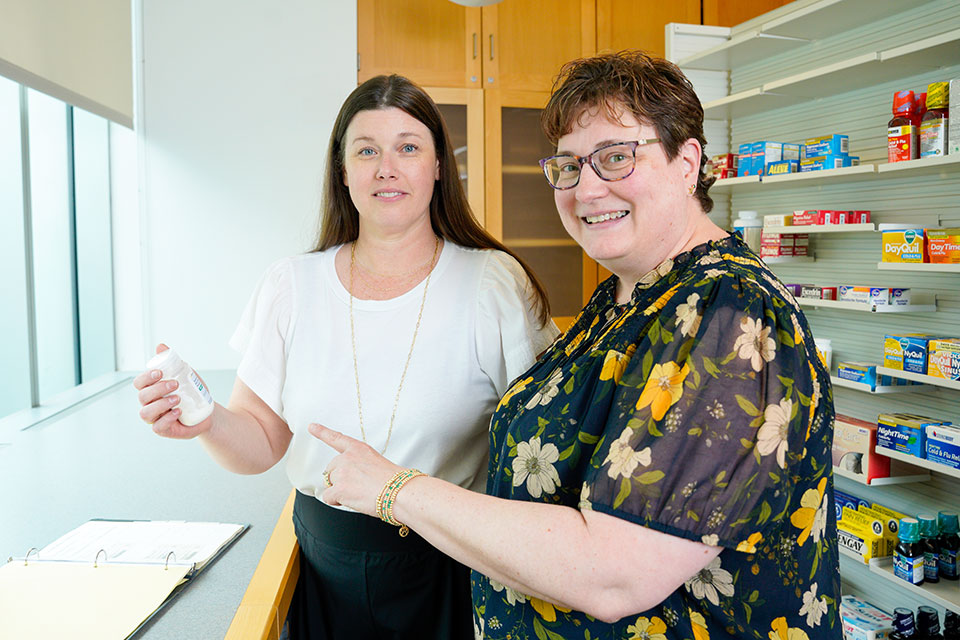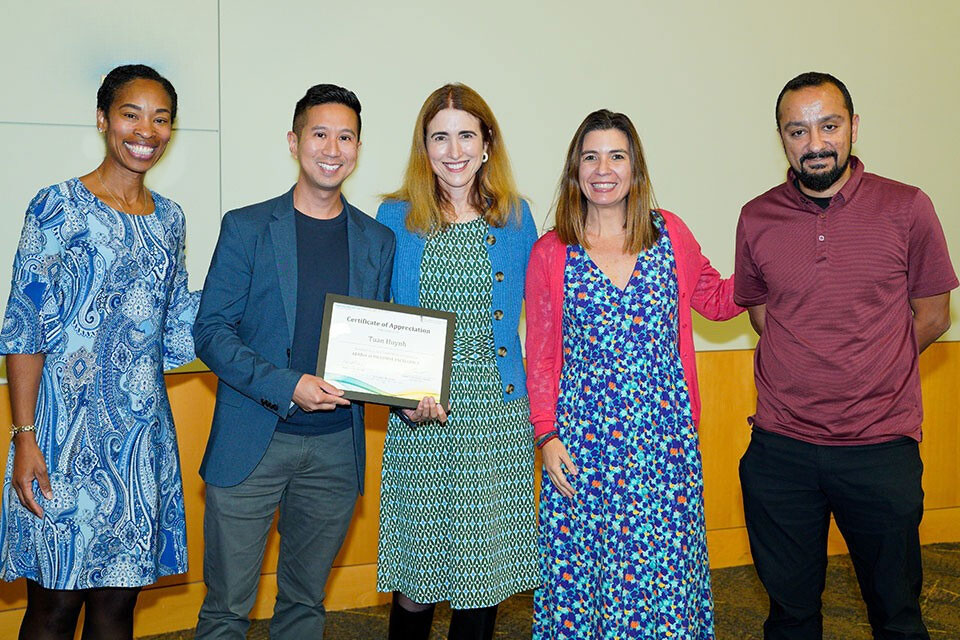Their Med List No Longer Has Kids Saying ‘Ew’
An evidence-based guide created by pharmacists at the University of Maryland is helping kids take their medicine — without the struggle — by tackling taste, one bitter drug at a time.

By Robyn Fieser, as published in Capsule, Summer 2025
September 12, 2025
From mixing antibiotics with pudding to freezing cough syrup into Popsicles, parents will try just about anything to get their kids to take bad-tasting medicines. And for years, the medical community wasn’t far behind. Health care practitioners and even hospitals were relying on the same tips and techniques, none of which were ever really proven to taste better. It was all based on anecdote and assumptions about what might work to help children better tolerate their medication.
Jill Morgan, PharmD, BCPS, BCPPS, FNAP, professor and chair of the Department of Practice, Sciences, and Health Outcomes Research and a pediatric pharmacist at the University of Maryland School of Pharmacy (UMSOP), and Amy Kruger Howard, PharmD ’17, MS ’21, a pediatric clinical pharmacist at UMSOP, knew there had to be a better way.
Nearly 75 percent of active pharmaceutical ingredients are bitter, and while capsules and tablets are designed to avoid taste issues, that doesn’t help infants and younger children who can’t swallow them. Liquid medicines are often the only option, but they taste awful. Worse
still, many of the common tricks used to hide the flavor just don’t disguise it.
The problem isn’t just children’s heightened perception of bitter taste. Poor palatability is directly linked to non-adherence, meaning children are more likely to skip or refuse doses altogether, which can be dangerous or even life-threatening.
So Morgan and Howard created the Ew Meds List™ — a comprehensive, evidence-based guide to the worst-tasting liquid medicines, along with proven strategies to make them taste better. Instead of relying on guesswork, the list provides pharmacists and providers with real tools that help — from better-tasting drug alternatives to pharmacy flavoring recommendations and home-based masking interventions. No more trial and error. No more bribery. Just science, with a little creativity on the side.
Now in the hands of pharmacists and providers, the Ew Meds List is helping caregivers make informed choices and getting kids the treatment they need.
“This is actually a huge problem, with the majority of medicines not tasting good,” says Morgan. “And it’s a big issue for kids with chronic health issues who have to take medication every day.”
Helping Children Take Their Meds
For decades, pediatric medicine has faced a persistent challenge.
Despite approximately 25 percent of all medicines being prescribed for children, most of these drugs are formulated for adults. This disconnect means the medicines are not optimized for taste, dosage, or ease of administration. As a result, providers, nurses, and pharmacists find themselves in a tough spot when trying to help parents ensure their children take their medicine.
A clear example of this issue came up during Howard’s fellowship in pediatric pharmacy under Morgan at the School of Pharmacy, when she encountered a young patient who needed IV antibiotics for a bone infection. After several days in the hospital, the child was discharged with a prescription for oral antibiotics to continue treatment at home. After just four or five days at home, the child spiked a fever, and it became evident that the infection was spreading again.
The problem? The child refused to take the bad-tasting antibiotics at home. Howard desperately tried to find ways to make the medicine more palatable and easier for the child to take. She ultimately tried using chocolate milk as a chaser and it worked. The child finished the course of antibiotics.
Unfortunately, this is a common situation — poor medicine adherence due to bad-tasting medicine can worsen a child’s condition, making them sicker and potentially prolonging their recovery. This longstanding issue is something many health care professionals have seen firsthand for years. After experiencing it repeatedly at their practice sites, Morgan and Howard decided it was time to act. They set to work on the Ew Meds List.
Morgan, Howard, and then-student Dafne Espinal Peña, PharmD ’24, took a direct and thorough approach. First, they surveyed health care prescribers to understand their knowledge of and practices around bad-tasting oral liquid medicines and taste masking. They found that few were confident in identifying unpleasant-tasting medicines, and most didn’t educate patients on masking techniques. While many suggested mixing medicine with food or drink, this technique can reduce drug effectiveness. The survey results underscored the need for better education on taste masking to ensure both adherence and efficacy.
The team then reviewed medical literature in databases like PubMed and Embase, focusing on studies involving children and keywords like “bitter,” “flavor,” “masking,” and “adherence.” Their search, limited to human randomized controlled trials and systematic reviews published between 1980 and 2021, focused specifically on studies with numerical taste ratings, which were converted to a five-point Likert scale. Medicines with scores below 2.5 were added to the Ew Meds List, while those rated 2.5 or higher were considered better-tasting.
Only a small number of medicines have evidence-based, flavormasking recommendations supported by research. For the rest of the medicines on the list, Morgan and Howard examined the pharmacologic properties of commonly used drugs and categorized them based on their likely dominant flavor profile. These profiles were then paired with findings from food science research on how to effectively mask bitter, sour, salty, or sweet tastes.
For example, to mask the taste of amoxicillin, one of the most prescribed antibiotics in the world, the list recommends flavors such as berry, fruit, or vanilla. Similarly, for the bitter taste of prednisone, flavors like chocolate, mint, or wild cherry can help mask it, while salty medicines may be masked with flavors such as apricot, butterscotch, peach, or vanilla.
This approach helps make medicines more palatable for children by matching the right masking flavors to each medicine’s taste. The list also includes a series of at-home practices to mask bad taste, such as giving something cold before the medicine to numb the taste buds like a Popsicle or using a sticky or sugary food to coat the tongue.
‘First Of Its Kind’
The Ew Meds List is now available on Pyrls, a clinical drug information platform developed by Derek Borkowski, PharmD, for clinicians and student clinicians. Pyrls offers a mobile app and web-based tools that provide evidence-based pharmacotherapy resources, making it easier to access essential drug information in clinical settings. Borkowski met Morgan and Howard at a conference and was quickly interested in adding their Ew Meds List to the Pyrls website, which covers a wide range of specific drugs.
According to Borkowski, the Ew Meds List used evidence-based research to fill a big gap that had previously been addressed with anecdotal opinions. The scientifically based analysis we’re able to provide to our users through the Ew Meds List is a first of its kind,” he says, adding that the list has received positive feedback from users in practice settings who interact frequently with parents and pediatric patients. One community pharmacist shared with him how he used it to help a parent select a compatible and effective flavoring to add to their child’s antibiotic.
Morgan and Howard’s innovative work is a shining example of UMSOP’s Pharmapreneurship initiative in action, which merges entrepreneurship and pharmacy to tackle real-world health care and research challenges. By fostering a mindset of critical thinking and problem-solving, Pharmapreneurship encourages students, faculty, staff, and alumni to think outside the box and push the boundaries of what’s possible.
The initiative offers a pathway within the School’s Doctor of Pharmacy curriculum that gives students a unique opportunity to develop their entrepreneurial skills through a specialized curriculum focused on innovation, business, and creative problem-solving. There are also business pitching competitions, workshops, seminars, and even scholarships focused on empowering future pharmacists to lead change not just in the lab or the clinic, but in the broader health care system.
For Morgan and Howard, the Ew Meds List is more than just a tool. It represents a step toward a future where pediatric care is revolutionized by innovation. They have a vision: to not only raise awareness among prescribers about the taste issues with certain medicines but also to encourage changes in prescribing habits and provide better guidance for parents. They’re exploring ways to integrate taste-related alerts into pharmacy systems, so when a medication is prescribed, a flag would notify both prescribers and parents about potential palatability issues.
While this is still a “pie in the sky” idea, it represents the kind of forward-thinking approach that defines the University of Maryland School of Pharmacy — and it’s just the beginning of a new era in health care.
View the full Summer 2025 edition of Capsule.


